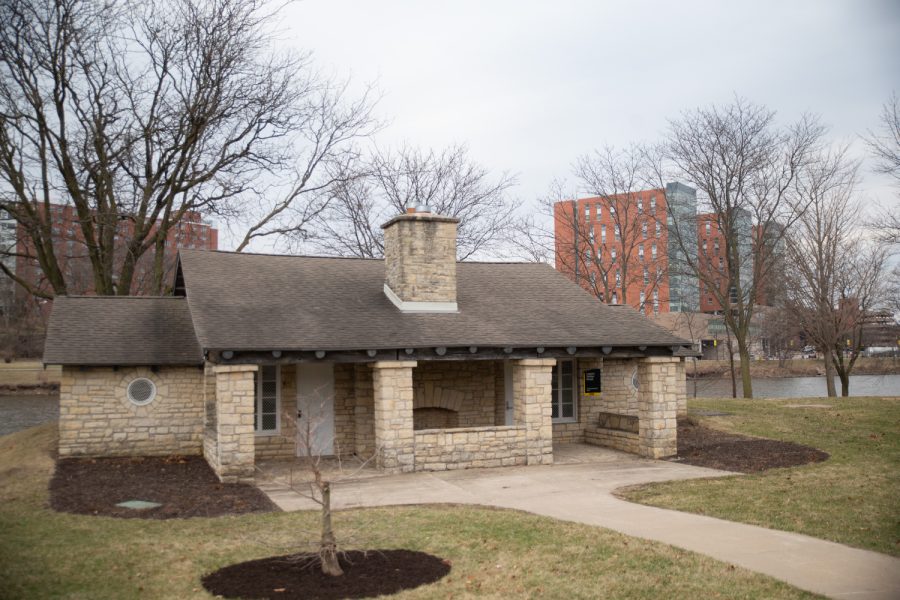Lagoon Shelter House offers new opportunities for outdoor recreation
After being primarily used for storage in the past, the Lagoon Shelter House and its surrounding area will soon offer more outdoor activities by the Iowa River.
The Lagoon Shelter House is seen on March 30, 2023. The Lagoon Shelter House is a facility managed by UI Recreational Services. (Shuntaro Kawasaki/The Daily Iowan)
April 25, 2023
As warmer weather approaches Iowa City, Recreational Services at the University of Iowa is preparing to increase the number of outdoor amenities available on campus.
Beginning this spring, the university’s Lagoon Shelter House will serve as a hub for adventure recreation, elevating the previously underutilized area and facility alongside the Iowa River toward its full potential.
Built in 1939 under the leadership of the UI’s first university architect George Horner, the stone house once acted as a space where the community could warm by a fire or put on their skates before heading out to a nearby frozen pond in the winter.
But as the Iowa River Improvement Project made changes to the area covered by the river and the university’s early arts campus developed, water no longer filled the pond, and it ceased to exist past the 1940s.
As time passed, the Lagoon Shelter House transitioned into a storage facility, offering a space to hold canoes, kayaks and other equipment used for recreation on the river, but it no longer fostered the same environment for community gathering as it had done with the pond.
The switch to storage was primarily because the university tried to find the most efficient use of the space, Rod Lehnertz, senior vice president for finance operations and current university architect, said.
With no air conditioning or heat, the building is limited in its capacity to host activities during the winter.
“It’s kind of a three seasons building,” Lehnertz said. “It’s not something that can be used all the time and easily.”
Following the 2008 flood, Lehnertz said the university updated the historic space to include updated lighting fixtures and plumbing lines for a single-user restroom. However, the historical foundation of the property remains intact. Lehnertz said the installation of an HVAC system would have required the entire structure of the building’s roof to be reconstructed.
David Patton, UI associate director of adventure recreation, is proposing several ideas to revitalize the house and the space surrounding it.
RELATED: Johnson County pushes Iowa River to be pedal paddle destination of the Midwest
By partnering with the university’s Landscape Services, Patton said he wants to encourage more activity in the area by adding hammocks and slacklining stations. Slacklining is an activity similar to tight rope walking where someone balances on a strip of wire fixed above the ground.
“That building is just sitting there,” Patton said. “We want to activate the green space on campus as much as possible.”
Patton’s vision does not stop at hammocks. He also mentioned the possibility of building smokeless fire pits for outdoor cooking, opening up the house to events, and installing artificial boulders for rock climbing.
“The bouldering wall is extremely popular this year at the Campus Recreation and Wellness Center,” Patton said. “People like to do that outdoors.”
Patton said by having outdoor rockclimbing opportunities in Iowa City, he hopes to make more outdoor recreation activities more accessible to all who wish to participate.
“The big hurdle with outdoor rec is sometimes you have to travel for things,” Patton said. “We’re trying to do things that are more inclusive and create opportunities for a wider variety of students to get involved.”
Nevertheless, Patton said implementing the boulders will not be possible without further funding and partnerships. He hopes that as people begin to use the area, they will see the value the building and river brings to the community.
Patton said he thought the lack of activity at the Lagoon Shelter House up until recently could have been in part because of the conditions of the river. He said he believes increasing opportunities for activity on and around the river will only further river cleanup efforts.
“I’ve noticed that when people go and experience the river and the environment, they’re more connected to it and then more respectful to it in the long run,” Patton said.
Patton added that while he hopes to increase recreational opportunities around the house, he also wants the building to be available for classes.
Some classes and instructors have already used the location as a ground for courses. UI School of the Wild Director Jay Gorsh used the space for his first-year seminar, Wild at Iowa, this past fall.
Gorsh said he thought the building provided a unique space to teach his students, as it could easily be transformed with folded tables and chairs to an open area.
“It creates this kind of nice environment for conversation because we’re not sitting at a desk or a table in a traditional classroom environment or lecture hall,” Gorsh said.
Despite being a non-traditional space to teach, Gorsh said the facility perfectly aligned with the course’s goals to inform students of the ways they can engage in outdoor recreation on campus and in the larger Iowa City area. Gorsh added spending more time outdoors is a practice all students can benefit from.
“Spending time in the outdoors can be almost therapeutic for any of us,” Gorsh said.
Gorsh said expanding outdoor recreational activities will provide students with a break that will help their mental health.
“It’s important as a university student, whether you are an undergrad or grad, to take time to unplug and step away from your normal routine and enjoy some time in the outdoors,” Gorsh said, “Even if it’s only for 20 minutes, just to hit the reset button.”



